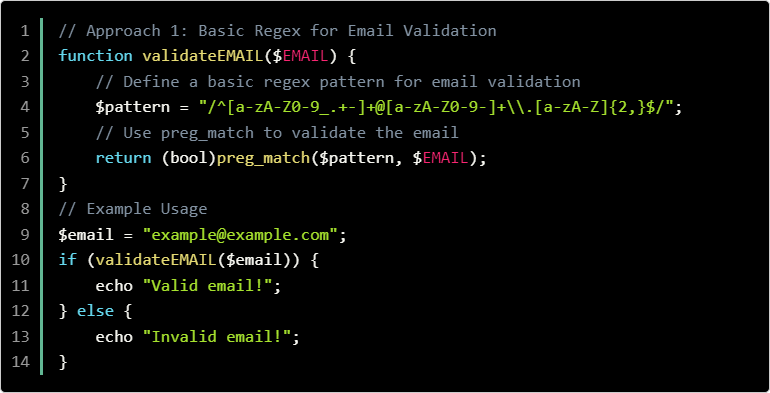
Introduction
If you’re building web forms, login systems, or newsletters, validating user email addresses is non-negotiable. PHP makes it easy, but the difference between basic validation and rock-solid implementation lies in the details.
Poor email validation can lead to spam signups, invalid data, or even security vulnerabilities. In this article, we’ll take a deep dive into Mastering PHP Email Validation: Techniques Every Developer Should Know and break down how to validate and sanitize emails like a pro.
Whether you’re new to PHP or looking to upgrade your skills, this guide walks you through everything from simple filters to robust protection techniques. Let’s get started.
Why Is Email Validation So Important?
Before jumping into code, it’s worth understanding why email validation matters so much in web development:
-
✅ Data Integrity: Avoids typos and ensures only valid data enters your database.
-
🔐 Security: Helps block header injection and other email-based attacks.
-
📬 Deliverability: Ensures messages are sent to real inboxes, not fake or malformed addresses.
-
🚫 Spam Prevention: Reduces the risk of bots flooding your system with fake accounts.
-
📊 Better Analytics: Clean email data means more accurate insights.
Now let’s move on to the techniques every developer should master.
Technique #1: Start with Basic Email Sanitization
Before you validate an email, always sanitize it. This strips out illegal characters and ensures the format is as clean as possible.
This step helps reduce common user input issues and prepares the data for deeper validation.
Technique #2: Validate the Email Format
Next, use PHP’s built-in filter to ensure the email meets standard formatting rules:
This check confirms that the structure of the email matches [email protected]. However, this only validates format, not whether the domain is real or the email exists.
Technique #3: Check the Email Domain’s DNS (MX Record)
To ensure the domain can receive mail, you’ll want to verify its MX records using PHP’s checkdnsrr() function:
This step weeds out fake or mistyped domains like [email protected].
Technique #4: Block Temporary or Disposable Emails
Bots and spammers often use disposable emails to bypass registration. You can block common temporary domains like this:
For best results, consider integrating a third-party API or maintaining a regularly updated list of banned domains.
Technique #5: Prevent Email Injection
Email injection is a form of attack that exploits email fields to send spam. Attackers inject newline characters (\n, %0A, etc.) into form fields. Prevent this with a simple regex function:
This is crucial if you’re sending emails using user input (e.g., in contact forms).
Technique #6: Combine Server-Side and Client-Side Validation
Client-side validation improves the user experience and reduces server load, but it should never be your only layer of defense. Here’s a simple example using HTML5:
Or JavaScript for advanced validation:
Always pair front-end validation with server-side checks for complete protection.
Technique #7: Full PHP Email Validation Script
Here’s how to put everything together into a clean, secure email validation flow:
This script sanitizes, validates, checks DNS, blocks disposable domains, and detects injection attacks—everything a pro developer should use.
Technique #8: Log and Analyze Invalid Email Attempts
Sometimes it’s helpful to log invalid or suspicious emails to track spam or abuse patterns.
Use these logs to improve your system over time or even create a blacklist for future prevention.
Bonus Tip: Use Email Validation Libraries or APIs
While PHP’s built-in functions work great, some services provide enhanced validation with mailbox pinging, role-based account detection, and deliverability scoring. Examples include:
-
ZeroBounce
-
Mailgun Email Validation
-
Kickbox
-
Abstract API
These tools are especially useful for applications that send bulk emails or rely on high deliverability.
Common Mistakes to Avoid
✅ Skipping sanitization before validation
✅ Relying only on front-end checks
✅ Ignoring MX record lookups
✅ Failing to block temp emails
✅ Not handling newlines or injection characters
Avoiding these mistakes will ensure your system stays robust and your database remains clean.
Conclusion
Email validation in PHP isn’t just a checkbox—it’s a critical part of building secure, scalable applications. From basic formatting checks to advanced injection prevention and domain validation, you now have a solid toolkit for ensuring clean, safe, and usable email input.
To recap, we covered:
-
Sanitization and formatting
-
DNS and MX record checks
-
Blocking temporary providers
-
Injection prevention
-
Full validation workflows
If you’re serious about data integrity and user security, take the time to implement these best practices.
Want a step-by-step breakdown you can revisit anytime? Check out Mastering PHP Email Validation: Techniques Every Developer Should Know for a clean, updated resource you can bookmark for future reference.